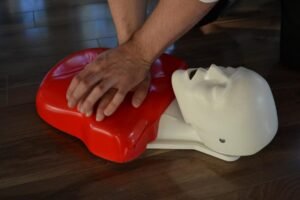During a thunder storm, it is important to stay indoors until the storm subsides. Take note that the worst thing that could happen is being struck by lightning. This is the reason why you have to stay indoors during a thunder storm.
First aid for lightning victims

1. Call or ask someone to call for emergency assistance right away. Readily provide the necessary information such as your location, directions to your location and the condition of the victim.
2. You have to assess the situation by determining the number of victims, if the thunder storm is still raging or if it is safe to provide first aid care. The priority is not to add more victims. Take note that you should not expose yourself to additional lightning risk. If necessary, you have to transfer the individual to a safe location before delivering first aid care. Additionally, check if the individual was directly struck by lightning or by the ground currents. The direct strikes are considered more serious.
3. Check if the individual is breathing and has a heartbeat. You can check for a pulse at the carotid artery in the neck or the femoral artery behind the knee. Do not forget that lightning can often lead to cardiac arrest.
4. Perform CPR. If the individual is not breathing or there is no heartbeat, you have to perform CPR with 2 rescue breaths followed by 30 chest compressions. Continue performing CPR until the medical team arrives. With this in mind, it is important to enroll in a first aid course so that you know what to do during emergencies.
5. Aside from respiratory and cardiac arrest, other possible lightning injuries include shock, burns, brain injury and skeletal damage. In some cases, blunt trauma can include ruptured organs and broken bones. Some even experience disruption with their nervous system with amnesia and loss of consciousness. It is important to treat all these injuries with basic first aid measures until the medical team arrives.
Possible injuries after a lightning strike
Aside from cardiac arrest or heart damage, other injuries all over the body are likely to occur after a lightning strike.
• In severe cases, individuals struck by lightning develop keraunoparalysis which is a temporary paralysis that is unique and only caused if an individual is subjected to a lighting strike.
• Individuals can also suffer from superficial burns. Even though some believe that deep burns can occur, they are rare.
• Skull fractures and injuries to the cervical spine can occur from an associated blunt trauma.
• Broken bones and dislocations
• Injury to the eyes resulting to visual problems or delayed formation of cataract.
• The eardrum can be ruptured resulting to hearing loss, pain and dizziness.
Treating for shock
You should also treat the individual for shock by positioning the individual down with the head slightly lower than the legs and torso.
What to expect at the hospital
Once the individual struck by lightning is taken to the emergency department at the nearest hospital, the medical team will assess the overall condition. The individual will be examined for any internal injuries, burns or even neurological problems.
